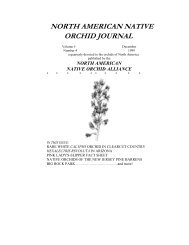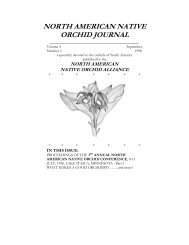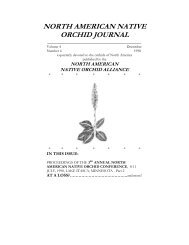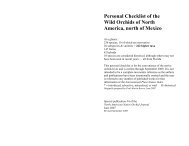north american native orchid journal - at The Culture Sheet
north american native orchid journal - at The Culture Sheet
north american native orchid journal - at The Culture Sheet
Create successful ePaper yourself
Turn your PDF publications into a flip-book with our unique Google optimized e-Paper software.
Folsom: A CASE FOR EVOLUTION<br />
Casual observ<strong>at</strong>ion can often notice<br />
differences in rel<strong>at</strong>ed species. Spiranthes<br />
cernua—a compilospecies—show gene<br />
flow or influence, from the basic diploid<br />
species th<strong>at</strong> are found within its range. In<br />
the Northeast, Spiranthes cernua shows a<br />
marked influence of S. ochroleuca and in the<br />
Midwest of S. magnicamporum. Spiranthes<br />
diluvialis, an allotetraploid species derived<br />
from S. magnicamporum and S. romanzoffiana<br />
has evolved into a solid, wide-ranging<br />
species th<strong>at</strong> although still rare, often<br />
occurs now where neither ancestral parent<br />
may be found (Sheviak, 1984).<br />
Lastly, alien species have arrived<br />
whether having been borne in on storm<br />
winds or hitchhiking a ride in cargo from<br />
far off lands or brought to our shores as a<br />
garden plant. An example in Florida is<br />
Zeuxine, the lawn <strong>orchid</strong>, our only annual<br />
<strong>orchid</strong>, and has seeded in all over the place<br />
but does not drive out <strong>n<strong>at</strong>ive</strong> species.<br />
Zeuxine has been documented to have<br />
arrived in lawn seed from the Far East in<br />
the 1920s. Another example would be<br />
Oeceoclades macul<strong>at</strong>a, the African spotted<br />
<strong>orchid</strong> with its beautiful mottled leaves.<br />
This species started to appear about 25<br />
years ago and has now insinu<strong>at</strong>ed itself<br />
through central and southern Florida. It is<br />
S. diluvialis<br />
assumed it first arrived as wind-borne seed from Africa and has<br />
also colonized several islands in the Caribbean. Further <strong>north</strong><br />
Epipactis helleborine, the broad-leaved helleborine, has been known<br />
in North America for more than a century after it was first seen<br />
near Syracuse, New York. It is now found throughout most of<br />
temper<strong>at</strong>e North America and shows a decided fondness for<br />
48













